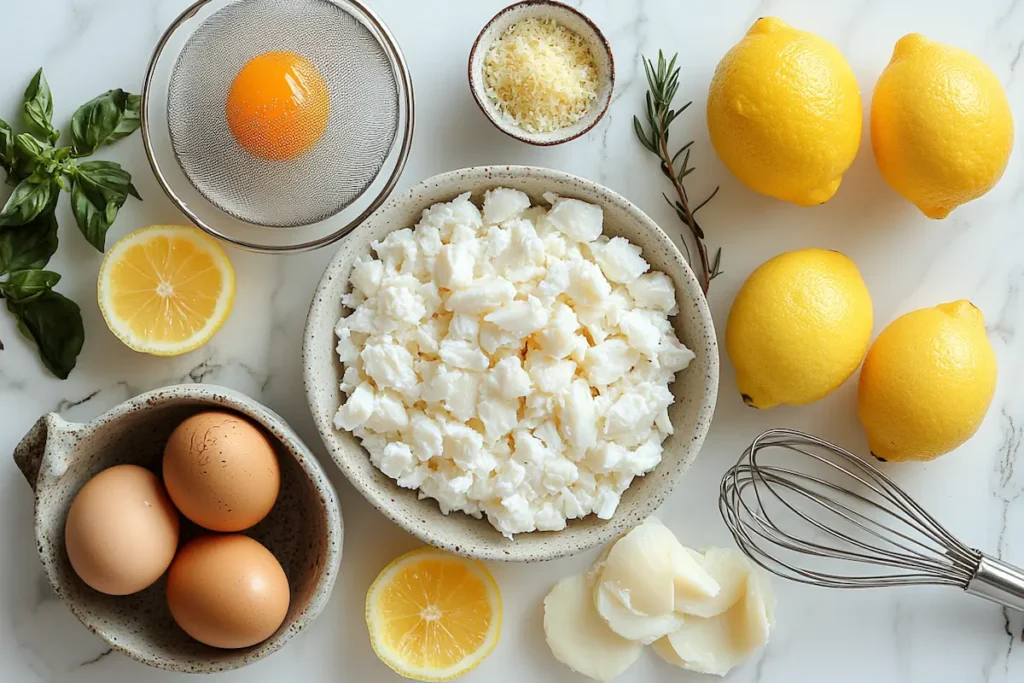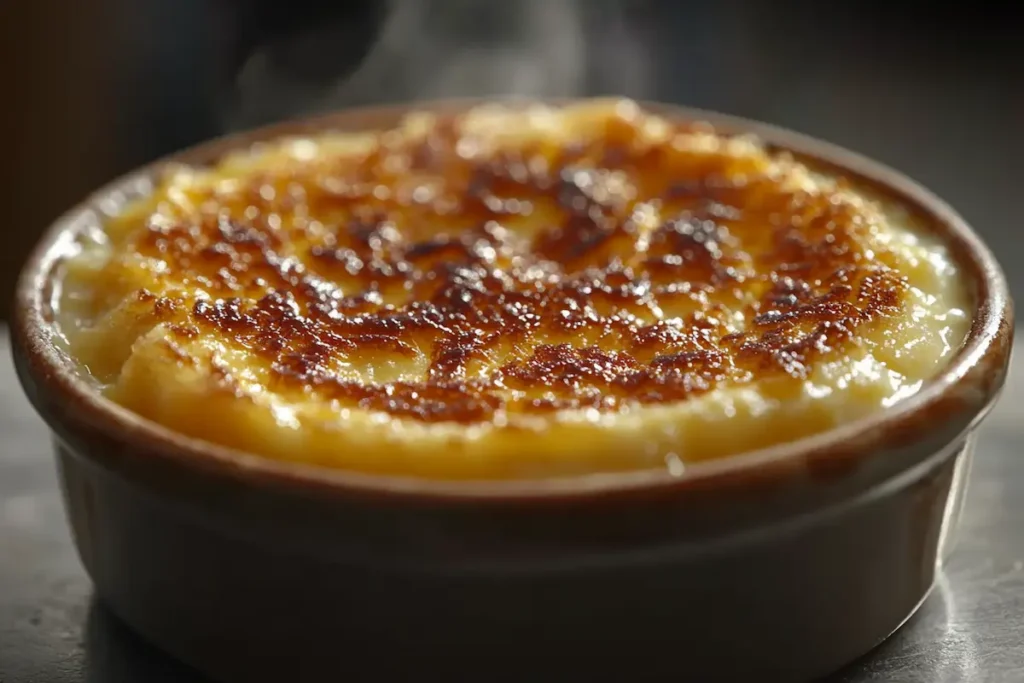A Unique Culinary Twist: The Unexpected Elegance of Crab Brûlée
The dim glow of the kitchen light flickered against the stainless steel countertops. The air was thick with the scent of the sea, and the gentle crackling of a kitchen torch broke the silence. It was the final touch melting sugar into a golden, caramelized shell. But this wasn’t an ordinary crème brûlée. Beneath the crisp topping lay something unexpected: tender, savory crab infused in a creamy custard.
Crab brûlée recipe might sound unusual, but its delicate balance of rich seafood and silky custard makes it a must-try for any adventurous cook. This dish transforms the familiar into something extraordinary, blending the elegance of French dessert with the bold flavors of fresh crab. Whether served as a sophisticated appetizer or a show-stopping main course, this recipe is bound to surprise and impress.
Before we get into the step-by-step process, let’s break down what you need to make this savory delicacy.
Cooking Time and Servings
- Prep Time: 25 minutes
- Cook Time: 40 minutes
- Total Time: 1 hour 5 minutes
- Servings: 4 individual portions
Table of contents
Ingredients for Crab Brûlée
Every great dish begins with the right ingredients. Here’s what you’ll need for this crab brûlée recipe and some useful substitutions.
| Ingredient | Amount | Notes & Substitutions |
|---|---|---|
| Fresh Crab Meat | 1 cup (168g) | Use canned or frozen if needed |
| Heavy Cream | 2 cups (476g) | No substitutions essential for texture |
| Large Egg Yolks | 5 | Creates the custard base |
| Salt | ½ tsp (3g) | Adjust to taste |
| Black Pepper | ¼ tsp | White pepper works as well |
| Nutmeg | ⅛ tsp | Adds warmth to the dish |
| Chopped Herbs | 1 tbsp | Parsley, chives, or tarragon |
| Granulated Sugar | 2 tbsp (24g) | For the caramelized topping |
| Lemon Zest | ½ tsp (optional) | Balances the richness |

Ingredient Notes & Substitutions
- Crab Meat: Fresh is best, but canned or frozen crab works if fresh isn’t available. Drain and pat dry canned crab to remove excess moisture.
- Heavy Cream: Essential for the smooth, silky texture. Do not substitute with milk or half-and-half.
- Herbs: Tarragon, chives, or parsley enhance the flavor. Experiment to find your favorite combination.
- Lemon Zest: Optional, but a small amount brightens the dish and balances the richness of the custard.
Step-by-Step Instructions
1. Preparing the Custard Base
- Preheat your oven to 320°F (160°C).
- Separate the egg yolks from the whites, placing the yolks in a mixing bowl.
- In a saucepan over medium heat, warm the heavy cream until it just begins to steam do not let it boil.
- Stir in the salt, black pepper, and nutmeg, blending well.
2. Tempering the Eggs
- Slowly pour the warm cream into the egg yolks, whisking constantly. This process, called tempering, prevents the eggs from scrambling.
- Strain the mixture through a fine-mesh sieve to remove any lumps, ensuring a smooth custard.
- Stir in the lemon zest (if using) and mix well.
3. Preparing the Ramekins
- Place four ramekins in a deep baking dish.
- Divide the crab meat evenly among the ramekins.
- Pour the custard mixture over the crab, filling each ramekin almost to the top.
4. Creating a Water Bath
- Carefully pour hot water into the baking dish until it reaches about one-third up the sides of the ramekins.
- This water bath, or bain-marie, helps the custard cook gently and evenly.
5. Baking the Crab Brûlée
- Transfer the baking dish to the oven and bake for 35-40 minutes or until the custard is set but slightly jiggly in the center.
- Remove from the oven and let the ramekins cool to room temperature.
- Cover and refrigerate for at least 3 hours or preferably overnight.
6. Caramelizing the Sugar Topping
- Before serving, sprinkle a thin layer of granulated sugar evenly over the top of each custard.
- Use a kitchen torch to caramelize the sugar until golden brown and crisp.
- Allow the sugar to set for a minute before serving.
Nutritional Breakdown
Here’s a nutritional estimate for one serving of crab brûlée:
| Nutrient | Amount per Serving |
|---|---|
| Calories | 325 kcal |
| Protein | 15g |
| Carbohydrates | 10g |
| Fats | 25g |
| Sugar | 6g |
| Sodium | 450mg |
The high protein content from crab meat makes this a satisfying dish, while the fats from cream and eggs contribute to its indulgent texture.
Now that you have mastered the preparation of crab brûlée, let’s explore how to serve it, the best side dishes, storage methods, and frequently asked questions. This section will ensure you get the most out of this unique dish, whether making it for a dinner party or a quiet evening at home.

Best Ways to Serve Crab Brûlée
1. Temperature Matters
- Slightly chilled or room temperature: Unlike traditional crème brûlée, which is best served cold, crab brûlée is more enjoyable when served slightly chilled or at room temperature. This allows the flavors to develop fully while keeping the texture creamy and smooth.
- Freshly caramelized top: Always brûlée the sugar topping just before serving for the best contrast between the crisp sugar crust and the soft custard beneath.
2. Ideal Garnishes
To enhance the presentation and add depth to the flavor, consider garnishing your crab brûlée with:
- Fresh herbs: A sprinkle of finely chopped chives, parsley, or tarragon adds freshness.
- Lemon zest: A light dusting of zest brightens up the dish and complements the crab.
- Microgreens: Adds a touch of elegance for a fine-dining feel.
3. Best Side Dishes to Serve with Crab Brûlée
Crab brûlée pairs well with both light and bold flavors. Here are some excellent side dish ideas:
| Side Dish | Why It Works |
|---|---|
| Crispy Baguette Slices | Adds crunch and balances the creamy texture. |
| Arugula Salad with Citrus Dressing | The peppery and citrusy notes contrast beautifully with the rich custard. |
| Roasted Asparagus | A simple, elegant vegetable pairing that enhances the dish. |
| Savory Cheese Crackers | Provides an extra layer of texture and saltiness. |
| Lemon Butter Shrimp | Complements the seafood essence of the dish. |
For a full gourmet experience, serve crab brûlée as an appetizer before a seafood main course like grilled salmon or lobster tail.
How to Store and Reheat Crab Brûlée
Refrigeration
If you have leftovers, here’s how to store them properly:
- Cover tightly: Use plastic wrap or an airtight container to prevent moisture loss.
- Refrigerate for up to 3 days: The custard will stay fresh but should be consumed within this period for optimal taste.
Freezing (Not Recommended)
While many custard-based dishes freeze well, crab brûlée is best enjoyed fresh. Freezing may cause the custard to separate, leading to a grainy texture upon thawing.
Reheating and Recaramelizing the Top
- Let it come to room temperature: Remove from the fridge at least 20 minutes before serving.
- Torch the sugar again: If the caramelized top has softened, sprinkle a fresh layer of sugar and torch it again for crispness.
- Avoid the oven: Heating the entire dish will ruin the delicate texture. Instead, use a kitchen torch to maintain the integrity of the custard while crisping the top.
Frequently Asked Questions (FAQs)
u003cstrongu003e1. What is the secret to crème brûlée?u003c/strongu003e
The key to a perfect u003cstrongu003ecrab brûléeu003c/strongu003e is u003cstrongu003eslow baking at a low temperatureu003c/strongu003e and u003cstrongu003eproper chillingu003c/strongu003e. Overcooking will cause the custard to curdle, while undercooking will leave it too runny. Always bake at u003cstrongu003e320°F (160°C)u003c/strongu003e and allow at least u003cstrongu003e3 hours of refrigerationu003c/strongu003e before serving.
u003cstrongu003e2. What does brûlée mean in cooking?u003c/strongu003e
The term u003cstrongu003ebrûléeu003c/strongu003e comes from the French word meaning u0022burnt.u0022 It refers to the caramelized sugar crust formed on top of custards like u003cstrongu003ecrab brûléeu003c/strongu003e by using a kitchen torch or broiler.
u003cstrongu003e3. What’s the difference between crème brûlée and custard?u003c/strongu003e
While both are made from eggs, cream, and sugar, u003cstrongu003ecrème brûléeu003c/strongu003e (and its savory variation, u003cstrongu003ecrab brûléeu003c/strongu003e) is baked in a water bath and topped with a caramelized sugar crust, whereas traditional custard is typically uncaramelized and served softer.
u003cstrongu003e4. What is in brûlée?u003c/strongu003e
A classic brûlée consists of u003cstrongu003ecream, egg yolks, sugar, and vanillau003c/strongu003e. In u003cstrongu003ecrab brûléeu003c/strongu003e, the vanilla is replaced with u003cstrongu003ecrab meat, herbs, and seasoningsu003c/strongu003e to create a savory twist on the traditional recipe.
Conclusion and Call to Action
Crab brûlée is an unexpected yet elegant dish that brings a unique twist to the world of fine dining. The combination of creamy seafood custard and a crisp sugar crust makes it a show-stopping appetizer or light main course.
Now it’s your turn try this recipe and let us know how it turns out! Have questions or creative variations? Share them in the comments below. Enjoy your crab brûlée, and happy cooking!

